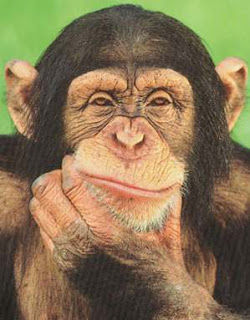It has been known since antiquity that people share many common features, both physical and behavioral, with the great apes, especially the two extant species of Pan, the common chimp and the pygmy chimp, or bonobo.
This was no more than a curiosity for most people until technology became available to sequence and compare genes between different species. Genes are like a book in which is written the story of our deep past, and generally the more similar the genomes of two species are, the more recently their evolutionary split occurred. And the closer they are related.
A landmark study was performed in 1973 that showed the full extent of our similarity with Pan troglodytes (the common chimpanzee) on a genetic level. This data as been updated and fine-tuned several times since then, most recently during the sequencing of the entire chimpanzee genome within the last few years.
Turns out our old feelings of familiarity were correct. We share around 94% of our DNA base pairs with chimps, and about 98% of active (coding) genes. That is an extraordinarily close relationship. If you want more detail consider that the chimp genome project found that...
"...the DNA sequence difference between humans and chimpanzees is about thirty-five million single-nucleotide changes, five million insertion/deletion events, and various chromosomal rearrangements."
That may seem like a lot, but only until you know that our DNA contains over 3 Billion base pairs. That's so close it's almost trivial. Add to this the fact that the vast majority of these changes are neutral and do not affect the phenotype:
"Only a very tiny fraction of those fixed differences gave rise to the different phenotypes of humans and chimpanzees and finding those is a great challenge."
In fact, our lineages are so close that if we were talking about any species other than our own, based on this evidence alone we would simply taxonomically move Pan troglodytes out of the family Pan and into the family Homo. Yes, we're that close. We've re-categorized species with far less DNA in common.
Ahh, but that would cause a stir, wouldn't it? We humans like to think that we are fundamentally different than "the animals", don't we? Amazing as it may seem, the invisible wall we have constructed around us is the only reason we don't have a species named Homo troglodytes in our world.
The split between our ancestors and those of Pan Troglodytes (aka the time of our last common ancestor) occurred between 4 and 6 million years ago. Our destinies have diverged in complex and profound ways since this event, which Richard Dawkins poetically calls "The Long Goodbye".
But we are still the same. As Carl Sagan has noted: "Bone for bone, muscle for muscle, there are almost no important differences between chimps and humans". And we share the same feelings, motivations, and fears.
Next time you see a chimp at the zoo, look into his eyes. You will see an obvious and familiar intelligence. You will see the same spark of thoughtfulness that we humans so conceitedly claim to monopolize. In a very real way, you will see yourself staring back at you.


1 comment:
Well written. I like that...The Long Goodbye.
Post a Comment